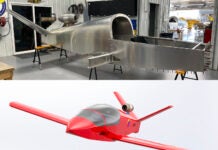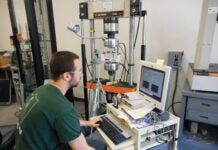
As I rolled the SubSonex to a stop in front of my hangar this morning, the mighty TJ-100 spooling down and going in to its cooling cycle, I noted two milestones on my kneeboard. The first – I have accumulated 30 hours of flight time on the little jet. The second – I finished the final test card in the series from the EAA Flight Test Manual. Now “finished” is, of course, a relative term. There are a few tests that I will probably repeat to see if I can do them with more precision. And there are a few that got severely edited because, well – the manual wasn’t written with a jet in mind! There are all sorts of strike-outs in my records, things like recording CHTs, EGTs, Oil Pressures and Temps – they are simply not applicable in the case of this machine.
But I have spent a fair amount of time watching phugoids (the airplane is nicely stable in pitch, thank you) and going around in circles seeking the elusive accelerated stall before running out of smash and falling into a spiral. I decided that spin testing is probably outside the envelope I want to try in the airplane (but its not in the EAA test cards anyway) and I had to add cruise performance testing way up to 17,500 feet! So yeah – there were a few accommodations, but I was able to work through all of the cards in the first thirty hours.

In that time, I’ve had a few mechanical things to work on – the retractable gear has given us a few surprises, although we have always gotten it down before landing – its just really tight in those little wheel wells, and easy to get an air hose in the wrong place, or (once) the cotter pin holding the nose gear axle nut in place hung up on a rivet head holding the door to the hinge. A little jiggling fixed that. The engine has been flawless, as have the avionics. We added landing/taxi lights to increase visibility – not because we intend to fly it at night, but otherwise, there have been no additions or deletions during Phase 1. And one great thing about the jet – no exhaust or oil leak stains anywhere on the fuselage! She’s clean as a whistle, although the insect season is rapidly approaching, and the forerunners have begun making splats on leading edges.
The airplane is fun to fly, but does make one think more methodically, and fly to strict procedural standards. Any time you’re having to work with “remove before flight” flags attached to explosive devices (the BRS), it makes you more methodical. We’ve found that even the preflight has to be a bit more rigid than with our other planes – for instance, applying anti-fog to my glasses so that air exhausted from the oxygen mask in the cold upper air doesn’t create an IFR situation in VFR conditions. Its a tiny cockpit, and once you’re buttoned in, there are few options for moving around.
So far, the airplane has lived up to Sonex performance specs, and it looks like cross-country legs of 250 nm (plus reserves) are going to be easy. But its not really a cross-country machine, and the fun factor is high, regardless of if you go anywhere or not! The airplane is a ramp magnet at fuel pumps, so I am allowing more time for fueling than with normal airplanes. We’ve still got ten hours in the Phase 1 box (which is actually quite large), and still on my personal agenda is doing some formation flying so that we can shoot some pictures. And it’s time to stretch her legs out to the limits of the Phase 1 region, maybe even venture across the Sierra and visit the lowlands of central California – just to see how it does in the thick air. There might even be a burger somewhere with my name on it, but it is probably going to cost more than a hundred bucks to go find it!














Thanks Paul or Ann for putting this on!